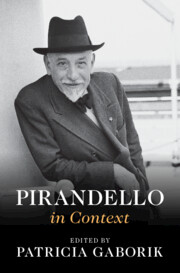Book contents
- Pirandello in Context
- Pirandello in Context
- Copyright page
- Dedication
- Contents
- Figures
- Contributors
- Preface
- Acknowledgments
- Chronology
- List of Cited Titles in Translation and the Original Italian
- Part I Places
- Chapter 1 Sicily
- Chapter 2 Rome
- Chapter 3 Germany
- Chapter 4 France
- Chapter 5 The United States
- Chapter 6 Latin America
- Part II Institutions
- Part III Interlocutors
- Part IV Traditions and Trends, Techniques and Forms
- Part V Culture and Society
- Part VI Reception and Legacy
- Further Reading
- Index
Chapter 6 - Latin America
from Part I - Places
Published online by Cambridge University Press: 14 March 2024
- Pirandello in Context
- Pirandello in Context
- Copyright page
- Dedication
- Contents
- Figures
- Contributors
- Preface
- Acknowledgments
- Chronology
- List of Cited Titles in Translation and the Original Italian
- Part I Places
- Chapter 1 Sicily
- Chapter 2 Rome
- Chapter 3 Germany
- Chapter 4 France
- Chapter 5 The United States
- Chapter 6 Latin America
- Part II Institutions
- Part III Interlocutors
- Part IV Traditions and Trends, Techniques and Forms
- Part V Culture and Society
- Part VI Reception and Legacy
- Further Reading
- Index
Summary
The introduction of Pirandello’s works to Latin America started in earnest after the controversial Italian success of Six Characters in Search of an Author (1921), which was then staged by Dario Niccodemi’s company in Buenos Aires, Montevideo, and Rio de Janeiro. When Pirandello’s newly established Teatro d’Arte found itself in serious financial trouble in 1927, it welcomed the proposal by the Teatro Odeón in Buenos Aires for a tour that promised to cover the deficit. On his first trip to South America the author sparked a fervor that made him the tour’s protagonist while dispelling the perception of his theatre as simply a conduit for Fascist propaganda. Pirandello’s second trip to Argentina in 1933 saw the author directing the successful world premiere of When One Is Somebody, which had not yet found an Italian production due to its autobiographical content and heavy technical requirements. An important connection between Pirandello and the Buenos Aires professional theatre scene was actor Luis Arata, whose company systematically offered his plays between the 1930s and 1940s. Over time, Pirandellian productions gradually spread across the official, commercial, and independent circuits, and Pirandellian tropes have continued to influence Argentine playwriting to this day.
Keywords
- Type
- Chapter
- Information
- Pirandello in Context , pp. 43 - 50Publisher: Cambridge University PressPrint publication year: 2024

